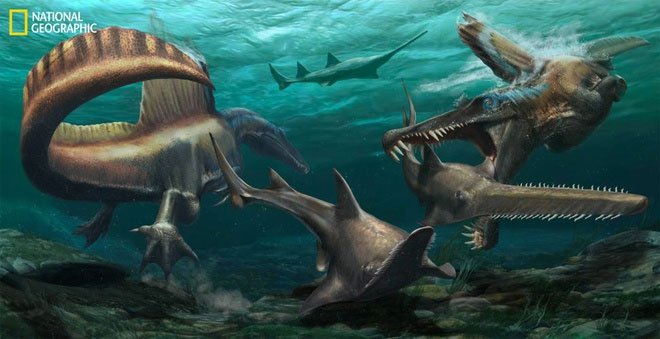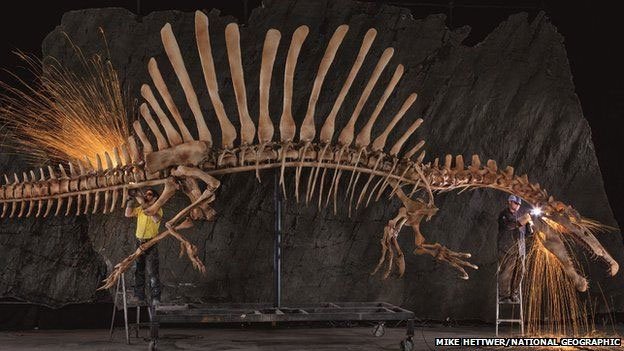The big question about dinosaurs was answered
After a long-standing question was answered, scientists confirmed that the first known human dinosaur could live underwater.
After years of searching for answers, scientists were finally able to conclude about the first dinosaurs to swim. Like Michael Phelps of prehistoric times, Spinosaurus aegyptiacus is a testament to how dinosaurs evolved and lived underwater, not just on land as many previous hypotheses.

Illustration of a dinosaur that can swim, hunt underwater, Spinosaurus aegyptiacus. (Photo: National Geographic).
Spinosaurus aegyptiacus is a large Cretaceous predator, has a long neck, a small crocodile-like muzzle and a small hole in the center of the skull that makes it easy to breathe when the head is submerged.
Although many archaeological details were discovered to confirm their shape, including a long snout and conical teeth, resembling modern crocodiles, paleontologists were unable to prove the animal could swim.
Previously, they believed that Spinosaurus ate fish, but most doubted that it would only wade along the coast, hunting in shallow water. The most important evidence that dinosaurs can swim is the way in which animals move underwater, yet to be found.
During excavation, only one Spinosaurus aegyptiacus skeleton was nearly complete, but most of the tail and vertebrae were missing. Because it has not been able to find the tail bone structure, paleontologists cannot confirm their hypotheses.
A new fossil, discovered in the Ice Cream region in southeastern Morocco, has changed everything. Paleontologist Nizar Ibrahim, of the University of Detroit Mercy and his team unearthed bones that account for about 80% of the tail length of a young Spinosaurus.
This tail does not look like other predators. It was tall and flat, like a fin.

Skeleton model of this dinosaur is on display in Washington DC, USA. (Photo: National Geographic).
To test how the tail would behave in water, the researchers created a plastic model of the tail and attached it to a robot controller.
They found that the tail produced eight times more repulsive force in the water than the tails of two dinosaurs with similar trunk structures. It resembles the tail of a modern crocodile or newt, two animals that live underwater but can also move on land.
"This finding has ended the debate that dinosaurs lived only on land but never lived in water. These dinosaurs particularly enjoyed hunting in deep water, not just waiting in the shallow water. " , said Nizar Ibrahim.
The findings were published in the journal Nature on April 29 and were immediately noticeable.
"This tail, for me, looks a lot like an aquatic species , " Jason Poole, a paleontologist at Drexel University, who was not involved in the study, told CNN.
Despite his ability to swim, Spinosaurus may not have gone too far from land, paleontologist Steve Brusatte of Edinburgh University told Gizmodo.
"It is clear that Spinosaurus can swim in shallow water, but its fossils are also found inland, so it probably lives comfortably both on land and in water," commented Brusatte.
- The largest animals have gone extinct
- Spinosaurus - Huge hunting dinosaurs on Earth
- 10 weird, hard to imagine dinosaurs
- People will be infected by aliens?
- Elon Musk's 'brain hack' riddle: CNBC is spread all over Manhattan but only one person answered correctly!
- Detecting lonely genes
- How many human genes?
- Arctic dinosaurs are only 20 years old
- How many scientists fabricated or misrepresented the research?
- Challenge the meteor hypothesis that extinct dinosaurs
- 10 misconceptions about dinosaurs
- What if dinosaurs live with humans?
- The new finding may help explain why the T-Rex dinosaur has very small arms
- 70 million years old dinosaurs
 Discovered an ancient centipede fossil 99 million years old
Discovered an ancient centipede fossil 99 million years old Discovered bat-like dinosaurs in China
Discovered bat-like dinosaurs in China Discovered a 200-year-old bronze cannon of the coast
Discovered a 200-year-old bronze cannon of the coast Discover 305 million-year-old spider fossils
Discover 305 million-year-old spider fossils